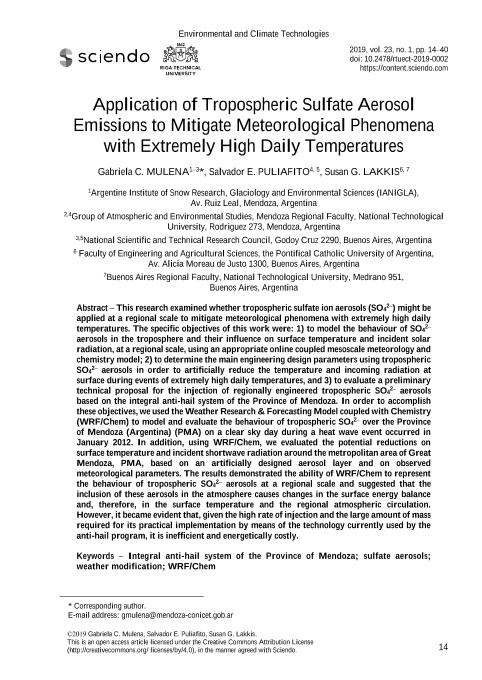Mostrar el registro sencillo del ítem
dc.contributor.author
Mulena, Gabriela Celeste

dc.contributor.author
Puliafito, Salvador Enrique

dc.contributor.author
Lakkis, Susan Gabriela

dc.date.available
2021-02-03T03:09:02Z
dc.date.issued
2019-03
dc.identifier.citation
Mulena, Gabriela Celeste; Puliafito, Salvador Enrique; Lakkis, Susan Gabriela; Application of Tropospheric Sulfate Aerosol Emissions to Mitigate Meteorological Phenomena with Extremely High Daily Temperatures; Sciendo; Environmental and Climate Technologies; 23; 1; 3-2019; 14-40
dc.identifier.issn
2255-8837
dc.identifier.uri
http://hdl.handle.net/11336/124543
dc.description.abstract
This research examined whether tropospheric sulfate ion aerosols (SO42-) might be applied at a regional scale to mitigate meteorological phenomena with extremely high daily temperatures. The specific objectives of this work were: 1) to model the behavior of SO42- aerosols in the troposphere and their influence on surface temperature and incident solar radiation, at a regional scale, using an appropriate online coupled mesoscale meteorology and chemistry model; 2) to determine the main engineering design parameters using tropospheric SO42- aerosols in order to artificially reduce the temperature and incoming radiation at surface during events of extremely high daily temperatures, and 3) to evaluate a preliminary technical proposal for the injection of regionally engineered tropospheric SO42- aerosols based on the Integral Anti-Hail System of the Province of Mendoza. In order to accomplish these objectives, we used the Weather Research & Forecasting Model coupled with Chemisty (WRF/Chem) to model and evaluate the behavior of tropospheric SO42- over the Province of Mendoza (Argentina) (PMA) on a clear sky day during a heat wave event occurred in January 2012. In addition, using WRF/Chem, we evaluated the potential reductions on surface temperature and incident shortwave radiation around the metropolitan area of Great Mendoza, PMA, based on an artificially designed aerosol layer and on observed meteorological parameters. The results demonstrated the ability of WRF/Chem to represent the behavior of tropospheric SO42- aerosols at a regional scale and suggested that the inclusion of these aerosols in the atmosphere causes changes in the surface energy balance and, therefore, in the surface temperature and the regional atmospheric circulation. However, it became evident that given the high rate of injection and the large amount of mass required for its practical implementation by means of the technology currently used by the anti-hail program, it is inefficient and energetically costly.
dc.format
application/pdf
dc.language.iso
eng
dc.publisher
Sciendo
dc.rights
info:eu-repo/semantics/openAccess
dc.rights.uri
https://creativecommons.org/licenses/by/2.5/ar/
dc.subject
SULFATE AEROSOLS
dc.subject
WEATHER MODIFICATION
dc.subject
WRF/CHEM
dc.subject
INTEGRAL ANTI-HAIL SYSTEM OF THE PROVINCE OF MENDOZA
dc.subject.classification
Meteorología y Ciencias Atmosféricas

dc.subject.classification
Ciencias de la Tierra y relacionadas con el Medio Ambiente

dc.subject.classification
CIENCIAS NATURALES Y EXACTAS

dc.subject.classification
Otras Biotecnología del Medio Ambiente

dc.subject.classification
Biotecnología del Medio Ambiente

dc.subject.classification
INGENIERÍAS Y TECNOLOGÍAS

dc.title
Application of Tropospheric Sulfate Aerosol Emissions to Mitigate Meteorological Phenomena with Extremely High Daily Temperatures
dc.type
info:eu-repo/semantics/article
dc.type
info:ar-repo/semantics/artículo
dc.type
info:eu-repo/semantics/publishedVersion
dc.date.updated
2020-11-20T17:51:53Z
dc.identifier.eissn
1691-5208
dc.journal.volume
23
dc.journal.number
1
dc.journal.pagination
14-40
dc.journal.pais
Letonia

dc.journal.ciudad
Riga
dc.description.fil
Fil: Mulena, Gabriela Celeste. Consejo Nacional de Investigaciones Científicas y Técnicas. Centro Científico Tecnológico Conicet - Mendoza. Instituto Argentino de Nivología, Glaciología y Ciencias Ambientales. Provincia de Mendoza. Instituto Argentino de Nivología, Glaciología y Ciencias Ambientales. Universidad Nacional de Cuyo. Instituto Argentino de Nivología, Glaciología y Ciencias Ambientales; Argentina. Universidad Tecnológica Nacional. Facultad Regional de Mendoza; Argentina
dc.description.fil
Fil: Puliafito, Salvador Enrique. Universidad Tecnológica Nacional. Facultad Regional de Mendoza; Argentina. Consejo Nacional de Investigaciones Científicas y Técnicas. Centro Científico Tecnológico Conicet - Mendoza; Argentina
dc.description.fil
Fil: Lakkis, Susan Gabriela. Pontificia Universidad Católica Argentina "Santa María de los Buenos Aires". Facultad de Ciencias Agrarias; Argentina. Universidad Tecnológica Nacional. Facultad Regional Buenos Aires; Argentina
dc.journal.title
Environmental and Climate Technologies
dc.relation.alternativeid
info:eu-repo/semantics/altIdentifier/doi/http://dx.doi.org/10.2478/rtuect-2019-0002
dc.relation.alternativeid
info:eu-repo/semantics/altIdentifier/url/https://content.sciendo.com/view/journals/rtuect/23/1/article-p14.xml?product=sciendo
Archivos asociados
